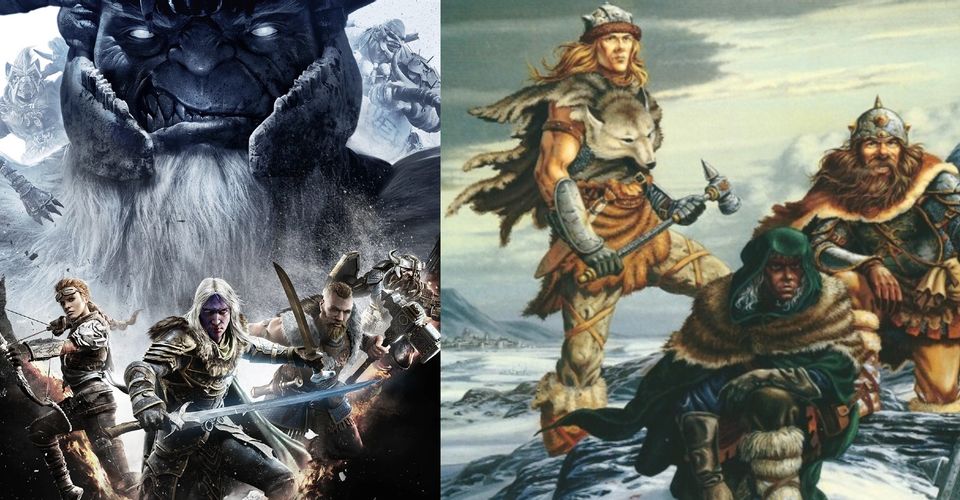Where D&D Dark Alliance Falls Within The Legend Of Drizzt

The Legend of Drizzt novels, a series set in the Forgotten Realms Dungeons & Dragons campaign setting centered on the dark elf ranger Drizzt Do’Urden, form one of the longest running fantasy epics, with 36 books to date. Dungeons & Dragons: Dark Alliance is the first video game exclusively featuring Drizzt and his companions as playable characters. The game takes place early in the timeline of the series, after the first published novel, The Crystal Shard, which was originally released in 1988 – more than 30 years prior to the release of D&D: Dark Alliance.
The Crystal Shard was the second Forgotten Realms novel ever published, following 1987’s Darkwalker on Moonshae, and it was the first book in The Icewind Dale Trilogy. Chronologically, The Dark Elf Trilogy (despite being published later) takes place first, revealing Drizzt’s backstory and his escape from the Underdark. This places D&D: Dark Alliance between the fourth and fifth books of The Legend of Drizzt in chronological order, and between the first and second book in published order.
Setting the new game so far back in the timeline of the Drizzt stories is an interesting move by developer Turque Games, as it appeals to nostalgia for longtime fans of the series. But it also recalls a time where the status quo was notably different for the characters. In the Forgotten Realms timeline, the events of The Crystal Shard took place between 1351 and 1356 DR (Dalereckoning), while current 5th edition D&D modules in the Forgotten Realms are typically set in the 1490s. The time jump accounts for changes in the Forgotten Realms setting that took place alongside new editions of D&D. Major events like the Time of Troubles, the Spellplague, and the Sundering altered the Forgotten Realms deities and flow of magic, providing in-fiction rationalization for the rule changes each edition brought to the game.
Crystal Shard-Era Drizzt Is Very Different From Modern D&D Drizzt

During that roughly 140-year period in the novels, three of D&D: Dark Alliance’s playable characters – Catti-brie, Bruenor, and Wulfgar – have died and returned through reincarnation into newly born, younger selves. At the time of The Crystal Shard, Drizzt was still establishing himself as a hero on the surface world, and an altriustic drow elf was an oddity in the setting. The five-year span of The Crystal Shard saw Wulfgar adopted by the dwarf Bruenor following a defeat in battle, and forging Wulfgar’s signature weapon, the magical hammer Aegis-fang. Catti-brie was given relatively little time to shine in the first book of The Icewind Dale Trilogy, and the early books in the series cast her and Wulfgar as a romantic pair. More recent stories feature her as Drizzt’s wife, but she was previously betrothed to Wulfgar, prior to the barbarian’s apparent death in later books.
The first published Drizzt novel covered a lot of ground. It established Drizzt as a hero out to prove to the surface dwellers that he had shunned the evil ways of the drow elves of the Underdark. Wulfgar and Drizzt killed the ice dragon Icingdeath, and Drizzt claimed the frost scimitar which he named after the slain dragon, one of his signature weapons to this day. Wulfgar’s five years under Bruenor’s tutelage caused him to move away from his tribe’s culture of conquest and violence, as he aided in allying the tribes with the Ten Towns settlements against the mutual threat of the evil wizard Kessel and his powerful relic, the Crystal Shard, which remains a major plot device in D&D: Dark Alliance. Wulfgar was originally intended to be the protagonist of the series, according to the author, with Drizzt as a sidekick of sorts, but the popularity of Drizzt changed the course of the series.
While the placement so early in the timeline is a bold choice for D&D: Dark Alliance, it does provide some advantages. With all four of the Companions of the Hall relatively early in their adventuring careers, there is more justification for the game’s depiction of them as mechanically low-level characters who improve over the course of the game. Catti-brie did not play a major role in The Crystal Shard, but she did establish herself as a skilled warrior and an important character in later books, so her inclusion as a playable character does not stand out as contradictory. Salvatore noted that when writing for a game, the priority is to ensure the story allows for the best game experience. While it is possible some veterans of The Legend of Drizzt novels might question how the series of adventures depicted in Dungeons & Dragons: Dark Alliance fits within the canon of the book series, the option to experience untold early adventures of Drizzt and his allies in a visceral action-RPG format is still an intriguing one.
About The Author
















